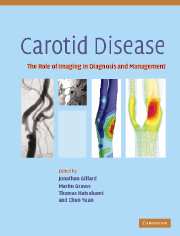Book contents
- Frontmatter
- Contents
- List of contributors
- List of abbreviations
- Introduction
- Background
- Luminal imaging techniques
- Morphological plaque imaging
- Functional plaque imaging
- Plaque modelling
- Monitoring the local and distal effects of carotid interventions
- Monitoring pharmaceutical interventions
- 30 Vascular imaging and the clinical development of new pharmaceuticals
- 31 Monitoring pharmaceutical interventions with conventional ultrasound (IMT)
- 32 Monitoring pharmaceutical interventions with IVUS
- 33 Monitoring of pharmaceutical interventions: MR plaque imaging
- Future directions in carotid plaque imaging
- Index
- References
30 - Vascular imaging and the clinical development of new pharmaceuticals
from Monitoring pharmaceutical interventions
Published online by Cambridge University Press: 03 December 2009
- Frontmatter
- Contents
- List of contributors
- List of abbreviations
- Introduction
- Background
- Luminal imaging techniques
- Morphological plaque imaging
- Functional plaque imaging
- Plaque modelling
- Monitoring the local and distal effects of carotid interventions
- Monitoring pharmaceutical interventions
- 30 Vascular imaging and the clinical development of new pharmaceuticals
- 31 Monitoring pharmaceutical interventions with conventional ultrasound (IMT)
- 32 Monitoring pharmaceutical interventions with IVUS
- 33 Monitoring of pharmaceutical interventions: MR plaque imaging
- Future directions in carotid plaque imaging
- Index
- References
Summary
Introduction
Cardiovascular disease now represents the leading cause of death and disability globally (Mackay and Mensah, 2004). Clinical trials designed to image vessel wall structure can be useful in the late clinical development of therapies targeting vascular disease and atherosclerosis. This review discusses the use of vascular imaging data to advance the development of new therapies from the perspective of the pharmaceutical industry. It will discuss the technologies currently used in large phase 3 studies, as well as the technical, clinical, and regulatory considerations that must be addressed for the purpose of drug development and regulatory approval.
In North America a number of marketed drug therapies have approved indications for use in slowing the progression of atherosclerosis (see Table 30.1). The regulatory registration for those indications was based upon imaging data from placebo-controlled clinical trials, some of which were large enough to demonstrate differences in the frequency of cardiovascular events. The efficacy of these antiatherosclerotic therapies, particularly statins, has led to the development of clinical guidelines and standards of care that preclude the possibility of conducting long-term placebo controlled trials to demonstrate antiatherosclerotic efficacy. If vascular imaging techniques are to be used in clinical drug development, they must be powerful enough to be capable of detecting meaningful differences in atheroma burden between new therapies and powerful active control therapies.
- Type
- Chapter
- Information
- Carotid DiseaseThe Role of Imaging in Diagnosis and Management, pp. 418 - 429Publisher: Cambridge University PressPrint publication year: 2006



